By Leen Randell
Updated: Jul 19, 2024
10 Best Herbal Creams For Dermatitis
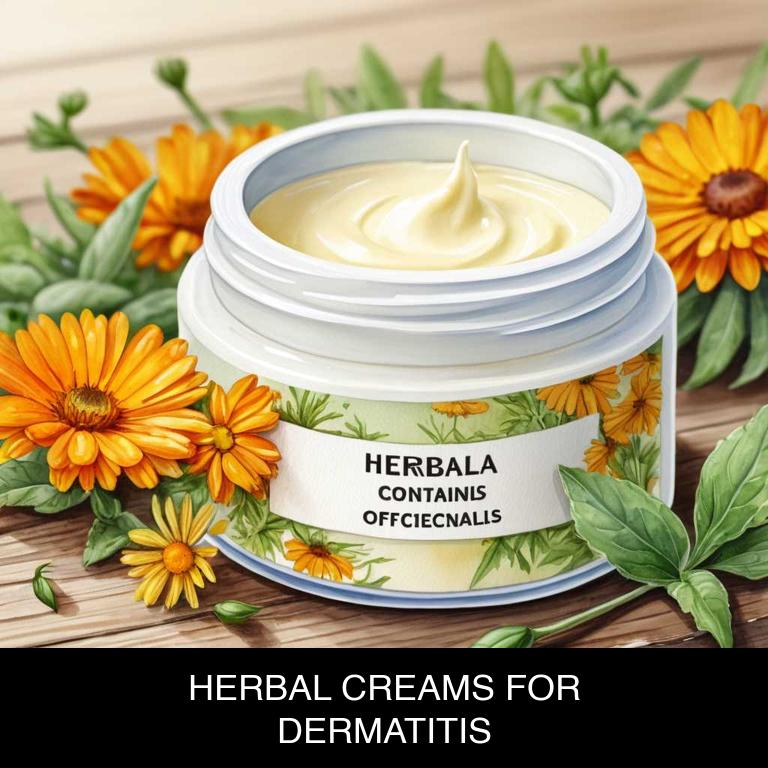
Herbal creams for dermatitis are topical treatments that combine natural herbs with moisturizing properties to soothe and calm irritated skin.
These creams help alleviate symptoms of dermatitis, such as redness, itching, and inflammation, by reducing the body's immune response. Examples of herbal creams include aloe vera, chamomile, and calendula creams, which have been shown to improve skin health and reduce discomfort.
By using these creams, individuals with dermatitis can experience relief from painful symptoms and improve their overall quality of life.
The following article describes in detail the most important creams for dermatitis, including medicinal properties, parts of herbs to use, and recipes for preparations.
- 1. Calendula officinalis
- 2. Aloe vera
- 3. Matricaria chamomilla
- 4. Melaleuca alternifolia
- 5. Lavandula angustifolia
- 6. Ginkgo biloba
- 7. Salvia officinalis
- 8. Thymus vulgaris
- 9. Cymbopogon citratus
- 10. Pelargonium graveolens
- What is the best combination of herbal creams to use for dermatitis?
- What ailments similar to dermatitis are treated with herbal creams?
1. Calendula officinalis
Calendula officinalis, also known as pot marigold, creams helps with dermatitis because of its anti-inflammatory and antiseptic properties.
The cream's active compounds, such as triterpenoids and flavonoids, soothe and calm irritated skin, reducing redness and swelling associated with dermatitis. Calendula's ability to promote wound healing and prevent infection makes it an effective treatment for dermatitis, allowing the skin to recover and repair itself.
This natural remedy provides long-lasting relief from the discomfort and itching caused by dermatitis.

Medicinal Constituents
The list below shows the primary medicinal constituents in Calendula officinalis creams that help with dermatitis.
- Calendulin: Calendulin is a triterpenoid saponin that helps with dermatitis by reducing inflammation and promoting tissue repair due to its ability to inhibit the production of pro-inflammatory cytokines.
- Carotenoids: Carotenoids, especially β-carotene, help with dermatitis by protecting the skin from oxidative stress and damage caused by free radicals, which can exacerbate skin conditions.
- Flavonoids: Flavonoids, such as kaempferol and quercetin, help with dermatitis by exhibiting anti-inflammatory and antioxidant properties, which can reduce redness, itching, and swelling associated with dermatitis.
Parts Used
The list below shows the primary parts of pot marigold used to make creams for dermatitis.
- Flowers: They are the primary source of Calendula officinalis's medicinal compounds, which are responsible for its anti-inflammatory and soothing properties.
- Leaves: They contain a similar set of compounds as the flowers, providing similar benefits for skin issues like dermatitis.
- Roots: They are also used to create creams due to their anti-inflammatory and antibacterial properties, making them a valuable addition to dermatitis treatments.
Quick Recipe
The following recipe gives a procedure to make a basic pot marigold for dermatitis.
- Infuse 50 grams of dried calendula officinalis flowers in 1 liter of hot water for 10 minutes.
- Strain the liquid and discard the solids to obtain 800 ml of infused liquid.
- Melt 200 grams of cocoa butter in a double boiler for 10 minutes to a temperature of 40°c.
- Combine the infused liquid and melted cocoa butter in a mixing bowl and stir until well combined.
- Pour the mixture into sterile glass jars and allow it to cool and set for 2 hours.
2. Aloe vera
Aloe vera, also known as aloe, creams helps with dermatitis because of its anti-inflammatory and soothing properties.
The gel extracted from the plant's leaves contains compounds like aloin and aloe-emodin, which calm irritated skin and reduce redness. Aloe vera creams also have moisturizing and protective qualities, helping to lock in moisture and shield the skin from environmental stressors.
This makes aloe vera creams an effective treatment for relieving symptoms of dermatitis, promoting faster healing and reducing the risk of future flare-ups.
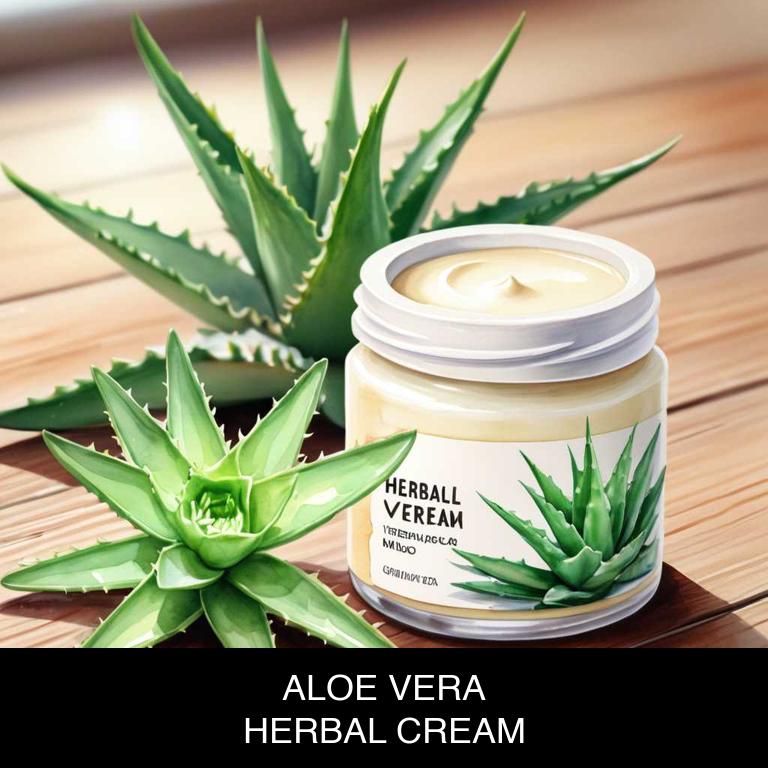
Medicinal Constituents
The list below shows the primary medicinal constituents in Aloe vera creams that help with dermatitis.
- Polysaccharides: These complex carbohydrates help soothe and calm irritated skin, reducing inflammation associated with dermatitis.
- Aloe-emodin: A phenolic compound with anti-inflammatory and antimicrobial properties, aloe-emodin helps to reduce redness, swelling, and the risk of infection in dermatitis.
- Vitamins a, c, and e: These antioxidants help protect the skin from damage caused by free radicals, promoting skin healing and reducing the severity of dermatitis symptoms.
Parts Used
The list below shows the primary parts of aloe used to make creams for dermatitis.
- Leaves: They contain the highest concentration of aloe vera's active compounds, including aloin and aloe-emodin, which have anti-inflammatory and soothing properties.
- Gel from leaves: The clear, jelly-like substance extracted from the leaves is rich in vitamins A, C, and E, as well as other nutrients that help to calm and moisturize the skin.
- Exudate from leaves: The exudate, a thick, yellowish sap, is a rich source of polysaccharides, which help to soothe and protect the skin, reducing inflammation and promoting healing.
Quick Recipe
The following recipe gives a procedure to make a basic aloe for dermatitis.
- Gather 1 cup of aloe vera gel from 2 to 3 fresh aloe vera leaves that have been harvested in the morning.
- Sterilize 1/2 cup of distilled water in a saucepan over low heat for 10 minutes.
- Combine the sterilized water with 1 tablespoon of vegetable glycerin and 2 tablespoons of beeswax in a double boiler.
- Mix 2 tablespoons of shea butter with 1 tablespoon of coconut oil in a separate double boiler over low heat.
- Blend the aloe vera gel mixture with the shea butter and coconut oil mixture until smooth and creamy.
3. Matricaria chamomilla
Matricaria chamomilla, also known as chamomile, creams helps with dermatitis because of its anti-inflammatory and soothing properties.
The creams contain compounds that reduce redness and itching, providing relief for individuals with irritated skin. The flavonoids and terpenoids present in chamomile help calm the skin, reducing inflammation and promoting a more even skin tone. Additionally, chamomile's antimicrobial properties help prevent infections and promote wound healing, making it an effective natural remedy for dermatitis.
This results in improved skin health and reduced discomfort.
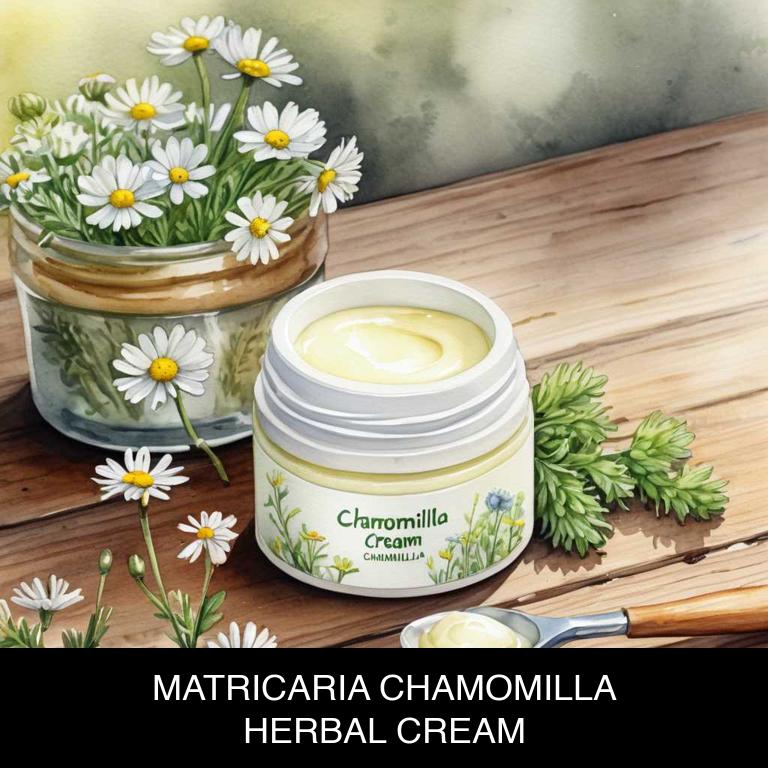
Medicinal Constituents
The list below shows the primary medicinal constituents in Matricaria chamomilla creams that help with dermatitis.
- Apigenin: This flavonoid helps with dermatitis by reducing inflammation and modulating the immune response, thereby alleviating skin irritation and discomfort.
- Luteolin: This flavonoid has anti-inflammatory properties, which help to reduce redness, itching, and swelling associated with dermatitis, promoting a faster recovery.
- Beta-bisabolol: This sesquiterpene alcohol has anti-inflammatory, antimicrobial, and antioxidant properties, making it effective in soothing and calming irritated skin, thus providing relief from dermatitis symptoms.
Parts Used
The list below shows the primary parts of chamomile used to make creams for dermatitis.
- Flowers: Used for their anti-inflammatory and soothing properties, which help calm and reduce skin irritation.
- Leaves: Employed for their antiseptic and anti-inflammatory properties, which aid in healing and protecting the skin.
- Seeds: Utilized for their soothing and anti-inflammatory effects, which help ease skin irritations and promote relaxation.
Quick Recipe
The following recipe gives a procedure to make a basic chamomile for dermatitis.
- Infuse 10 grams of dried matricaria chamomilla flowers in 100 ml of boiling water for 5 minutes.
- Strain the infusion through a cheesecloth into a clean container and discard the solids immediately.
- Mix 20 grams of beeswax with 20 grams of cocoa butter in a double boiler at 180 degrees fahrenheit.
- Combine the cooled herb infusion with the melted beeswax and cocoa butter mixture in a ratio of 1:3.
- Whip 100 grams of coconut oil with the matricaria chamomilla cream mixture until it becomes smooth and creamy.
4. Melaleuca alternifolia
Melaleuca alternifolia, also known as tea tree, creams helps with dermatitis because of its potent antimicrobial and anti-inflammatory properties.
The active compound, terpinen-4-ol, is responsible for its therapeutic effects. It has been shown to reduce redness, swelling, and itching associated with dermatitis, promoting a faster recovery.
Additionally, tea tree oil's antiseptic properties help prevent infection and promote wound healing, making it an effective treatment for skin conditions like eczema and acne, and other forms of dermatitis.
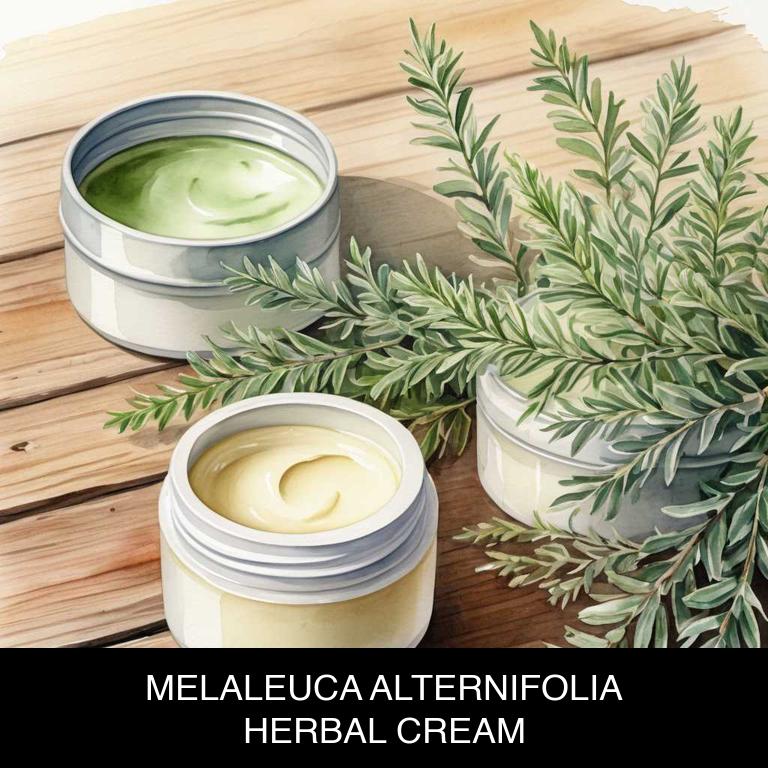
Medicinal Constituents
The list below shows the primary medicinal constituents in Melaleuca alternifolia creams that help with dermatitis.
- Cineole: This terpene constituent helps with dermatitis by reducing inflammation and itching due to its antiseptic and anti-inflammatory properties.
- Cymene: This monoterpenic hydrocarbon constituent has antiseptic and antimicrobial properties, which help to combat bacterial and fungal infections that can contribute to dermatitis.
- Linalool: This terpene constituent has anti-inflammatory and antiseptic properties, which help to soothe and calm irritated skin, reducing redness and swelling associated with dermatitis.
Parts Used
The list below shows the primary parts of tea tree used to make creams for dermatitis.
- Leaves: The leaves of Melaleuca alternifolia are primarily used due to their high concentration of melaleuca oil, which is a key component in creams for treating dermatitis.
- Seeds: The seeds are used because they contain a high amount of melaleuca oil, which is effective in soothing and calming skin irritations associated with dermatitis.
- Barks: The barks of Melaleuca alternifolia are utilized because they contain compounds that have anti-inflammatory and antiseptic properties, helping to reduce skin inflammation and prevent infection.
Quick Recipe
The following recipe gives a procedure to make a basic tea tree for dermatitis.
- Weigh 500 grams of beeswax and 500 grams of cocoa butter in separate scales.
- Melt the beeswax in a double boiler over low heat for 10 minutes.
- Add 500 grams of distilled water to 10 grams of melaleuca alternifolia essential oil in a bowl.
- Combine the melted beeswax and cocoa butter in a large mixing bowl.
- Add the melaleuca alternifolia water mixture to the beeswax mixture and blend for 5 minutes.
5. Lavandula angustifolia
Lavandula angustifolia, also known as English lavender, creams helps with dermatitis because of its anti-inflammatory and soothing properties.
The active compounds in lavender oil, such as linalool and linalyl acetate, have been shown to reduce redness and irritation associated with dermatitis. By applying a lavender cream topically, individuals can experience relief from itching and discomfort, promoting a faster recovery and improved skin health.
The calming effects of lavender cream can also help reduce stress and anxiety, which can exacerbate dermatitis symptoms.

Medicinal Constituents
The list below shows the primary medicinal constituents in Lavandula angustifolia creams that help with dermatitis.
- Linalool: This terpene has anti-inflammatory properties that help reduce redness and swelling associated with dermatitis.
- Linalyl acetate: This terpene has antioxidant properties that help protect the skin from damage caused by free radicals and reduce inflammation.
- Lavandulol: This terpene has antiseptic and antimicrobial properties that help prevent bacterial infections and promote wound healing in dermatitis-prone skin.
Parts Used
The list below shows the primary parts of english lavender used to make creams for dermatitis.
- Leaves: They contain antiseptic and anti-inflammatory compounds that help soothe and calm irritated skin.
- Flowers: The essential oils extracted from the flowers have antiseptic, anti-inflammatory, and antispasmodic properties, which help to reduce redness and itching associated with dermatitis.
- Seeds: They contain antioxidants and other compounds that help to protect the skin from damage and promote healing.
Quick Recipe
The following recipe gives a procedure to make a basic english lavender for dermatitis.
- Harvest 1 pound of fresh lavandula angustifolia flowers at peak bloom to ensure maximum potency.
- Dry the flowers in a dehydrator at 95°f for 2 hours to preserve their medicinal properties.
- Steep 1 cup of dried lavandula angustifolia flowers in 2 cups of boiling distilled water for 10 minutes.
- Strain the lavandula angustifolia infusion and combine it with 1/2 cup of beeswax and 1/4 cup of coconut oil.
- Whip the mixture until it thickens and reaches a consistency suitable for application to the skin.
6. Ginkgo biloba
Ginkgo biloba, also known as maidenhair tree, creams helps with dermatitis because of its anti-inflammatory and antioxidant properties.
The extract of the Ginkgo biloba leaves contains flavonoids and terpenoids that soothe and calm irritated skin, reducing redness and inflammation associated with dermatitis.
Additionally, Ginkgo biloba creams have been shown to improve blood flow to the skin, promoting healing and reducing itching, making it a popular natural remedy for relieving symptoms of dermatitis and promoting skin health.
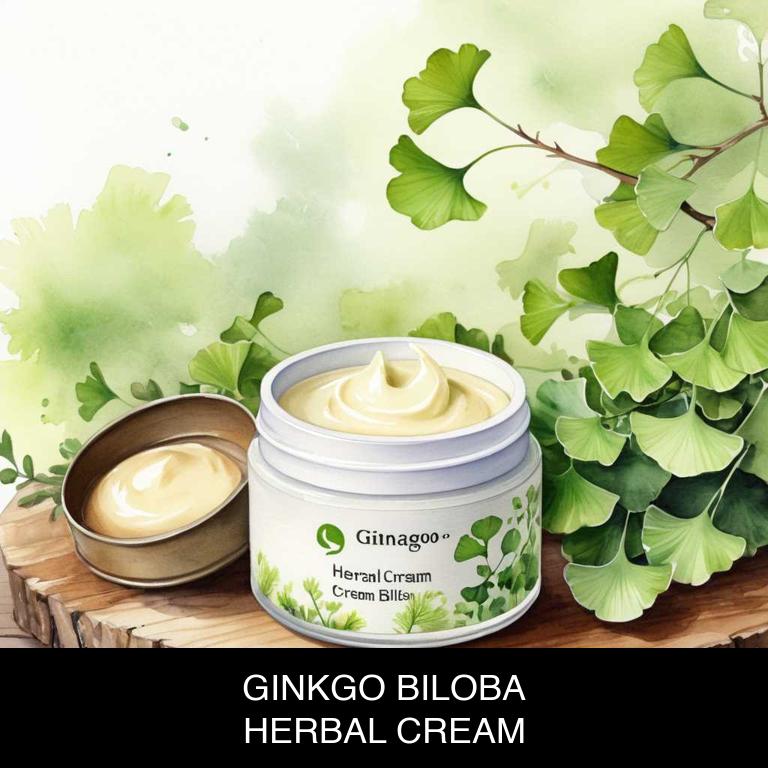
Medicinal Constituents
The list below shows the primary medicinal constituents in Ginkgo biloba creams that help with dermatitis.
- Bilobalide: This triterpene derivative helps reduce inflammation and soothe skin irritation associated with dermatitis by inhibiting the release of pro-inflammatory mediators.
- Quercetin: As a flavonoid phenolic compound, quercetin exhibits potent anti-inflammatory and antioxidant properties, which help alleviate skin redness, itching, and swelling characteristic of dermatitis.
- Isorhapontigenin: This flavonoid compound has shown anti-inflammatory and anti-oxidative activities, which can help protect the skin from damage caused by free radicals and reduce the severity of dermatitis symptoms.
Parts Used
The list below shows the primary parts of maidenhair tree used to make creams for dermatitis.
- Leaves: The leaves contain flavonoids and terpenoids, which have anti-inflammatory and antioxidant properties that help soothe and calm skin irritations.
- Seeds: The seeds contain ginkgolic acids, which have anti-inflammatory and antimicrobial properties that aid in reducing inflammation and preventing infections in dermatitis.
- Barks: The barks contain flavonoids and terpenoids, which help to reduce inflammation and promote wound healing, making them useful for dermatitis creams.
Quick Recipe
The following recipe gives a procedure to make a basic maidenhair tree for dermatitis.
- Mix 10 grams of dried ginkgo biloba leaves with 20 grams of beeswax in a double boiler.
- Heat the mixture at 160°f for 30 minutes to melt the beeswax completely.
- Add 20 grams of coconut oil and 10 grams of shea butter to the mixture.
- Stir the mixture for 10 minutes until it reaches a smooth and consistent texture.
- Pour the mixture into small containers and let it cool and solidify at room temperature for 2 hours.
7. Salvia officinalis
Salvia officinalis, also known as sage, creams helps with dermatitis because of its anti-inflammatory and antioxidant properties.
The salvenolides present in sage have been shown to reduce inflammation and promote wound healing, which can be beneficial for skin conditions such as eczema and dermatitis.
Additionally, sage's antimicrobial properties help to combat infections that can exacerbate dermatitis, promoting a healthy balance of the skin's natural flora and reducing symptoms of the condition.
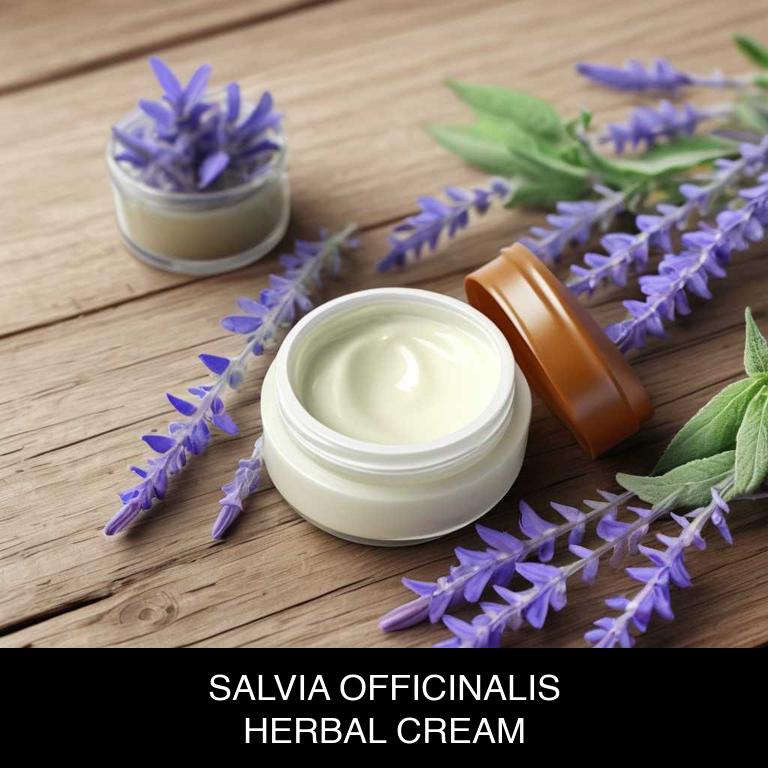
Medicinal Constituents
The list below shows the primary medicinal constituents in Salvia officinalis creams that help with dermatitis.
- Rosmarinic acid: A polyphenolic compound that exhibits anti-inflammatory properties, which can help reduce redness and swelling associated with dermatitis.
- Caryophyllene oxide: A sesquiterpene oxide that has been shown to exhibit anti-inflammatory and antioxidant activities, which can help soothe and protect the skin from irritation and damage.
- Ursolic acid: A triterpenoid that has been found to possess anti-inflammatory and antimicrobial properties, which can help reduce inflammation and prevent infection in dermatitis-prone skin.
Parts Used
The list below shows the primary parts of sage used to make creams for dermatitis.
- Leaves: Rich in antioxidants and anti-inflammatory compounds, which help soothe and calm irritated skin.
- Flowers: Contain flavonoids and other compounds that have anti-inflammatory and antiseptic properties, useful for treating skin conditions.
- Roots: Used for their antimicrobial properties and ability to help reduce inflammation and promote healing in the skin.
Quick Recipe
The following recipe gives a procedure to make a basic sage for dermatitis.
- Harvest 30-50 grams of fresh salvia officinalis leaves at the peak of flowering or during the summer months.
- Steep the leaves in 200 milliliters of carrier oil such as sweet almond oil for 2-3 weeks in a cool dark place.
- Strain the mixture through a cheesecloth into a bowl to separate the oil from the plant material.
- Combine 10 grams of beeswax and 20 grams of cocoa butter in a double boiler and melt until smooth.
- Blend the infused oil with the melted wax and butter mixture and pour into containers for cooling.
8. Thymus vulgaris
Thymus vulgaris, also known as thyme, creams helps with dermatitis because of its anti-inflammatory and antimicrobial properties.
The active compounds in thyme, such as thymol and carvacrol, have been shown to reduce inflammation and combat bacterial and fungal infections that can exacerbate dermatitis. Additionally, thyme's antioxidant properties help to soothe and calm the skin, promoting healing and reducing redness and irritation.
This natural remedy has been used for centuries to treat various skin conditions, making it a popular and effective treatment option for dermatitis.
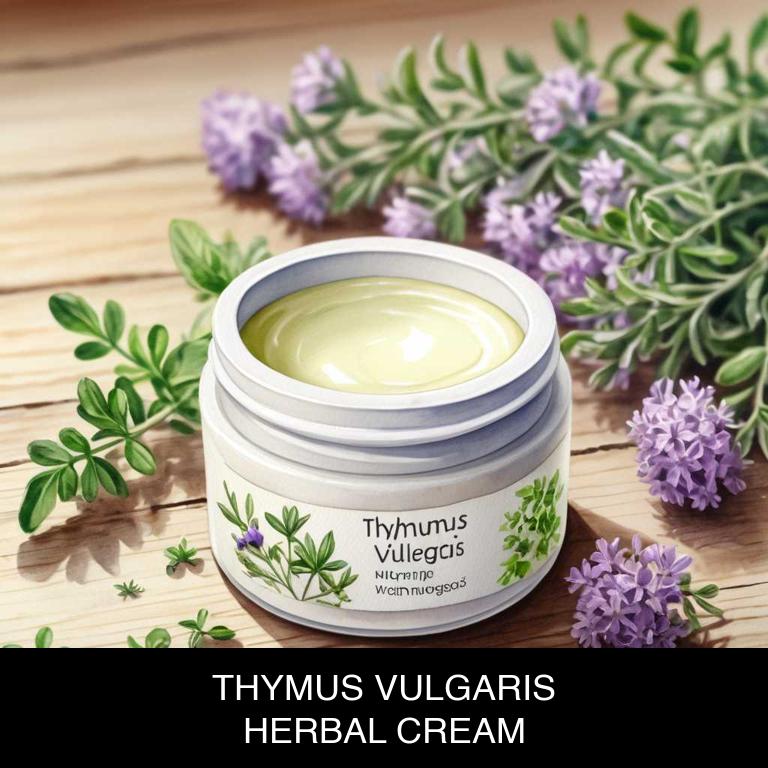
Medicinal Constituents
The list below shows the primary medicinal constituents in Thymus vulgaris creams that help with dermatitis.
- Carvacrol: It helps with dermatitis by exhibiting anti-inflammatory and antimicrobial properties, which can reduce skin irritation and prevent infection.
- Thymol: It helps with dermatitis by acting as a potent antioxidant and antimicrobial agent, which can soothe and protect the skin from damage caused by free radicals and microorganisms.
- Rosmarinic acid: It helps with dermatitis by displaying anti-inflammatory and antioxidant properties, which can reduce redness, swelling, and skin damage associated with dermatitis.
Parts Used
The list below shows the primary parts of thyme used to make creams for dermatitis.
- Leaves: Thymus vulgaris leaves are the most commonly used part, due to their high concentration of thymol and other bioactive compounds that provide anti-inflammatory and antiseptic properties.
- Flowers: Thymus vulgaris flowers are used for their fragrance and antiseptic properties, which are beneficial in soothing skin irritations and promoting wound healing.
- Stems: Thymus vulgaris stems are also used, particularly for their antiseptic and anti-inflammatory properties, which help to reduce redness and itching associated with dermatitis.
Quick Recipe
The following recipe gives a procedure to make a basic thyme for dermatitis.
- Infuse 50 grams of dried thymus vulgaris leaves in 1 liter of carrier oil such as coconut oil.
- Heat the mixture gently for 2 hours at 60 to 80 degrees celsius in a double boiler.
- Strain the mixture through cheesecloth into a clean glass container and discard the solids.
- Combine 10 grams of beeswax and 10 grams of shea butter in a small saucepan and melt over low heat.
- Mix the infused oil with the melted wax and shea butter mixture and whip until it thickens into a cream.
9. Cymbopogon citratus
Cymbopogon citratus, also known as lemongrass, creams helps with dermatitis because of its anti-inflammatory and antiseptic properties.
The essential oils present in lemongrass have been shown to soothe and calm irritated skin, reducing redness and itching associated with dermatitis. The cream's moisturizing properties also help to hydrate and protect the skin, promoting a healthy barrier function and aiding in the healing process.
This makes lemongrass creams a popular natural remedy for managing dermatitis symptoms.
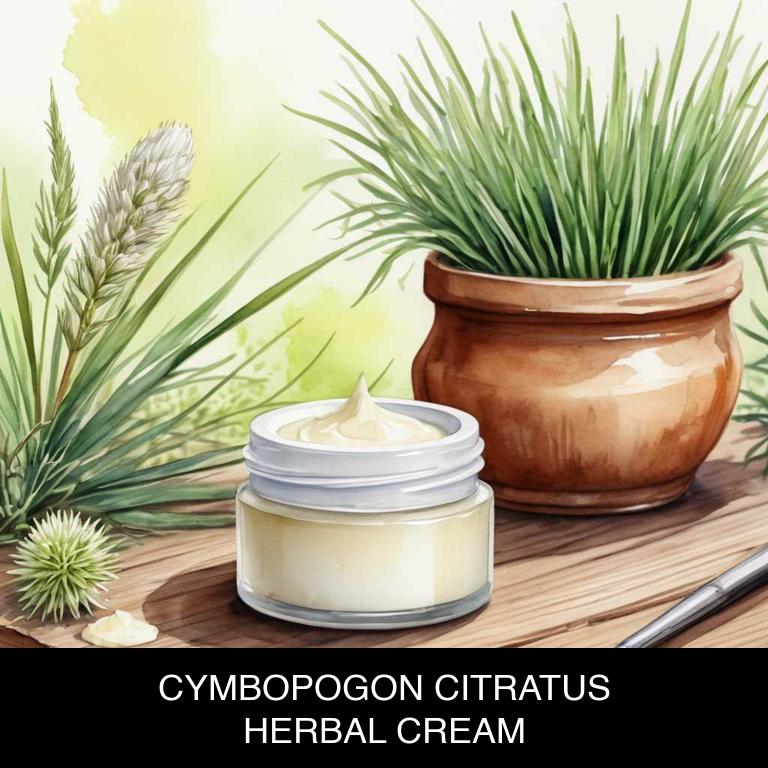
Medicinal Constituents
The list below shows the primary medicinal constituents in Cymbopogon citratus creams that help with dermatitis.
- Citral: Citral acts as an anti-inflammatory agent, reducing redness and swelling associated with dermatitis.
- Geraniol: Geraniol exhibits antimicrobial properties, preventing the growth of bacteria and fungi that can exacerbate dermatitis.
- Limonene: Limonene has antioxidant and anti-inflammatory effects, helping to soothe and calm irritated skin, thereby relieving symptoms of dermatitis.
Parts Used
The list below shows the primary parts of lemongrass used to make creams for dermatitis.
- Leaves: Known for their antiseptic and anti-inflammatory properties, which help soothe and calm irritated skin.
- Stems: Used for their citral content, which has antimicrobial and anti-inflammatory effects, aiding in the treatment of dermatitis.
- Rhyzomes: Employed for their oil content, which has anti-inflammatory and antiseptic properties, making them effective in reducing skin inflammation and promoting healing.
Quick Recipe
The following recipe gives a procedure to make a basic lemongrass for dermatitis.
- Harvest 250 grams of fresh leaves, preferably in the morning after the dew has evaporated but before the heat of the day.
- Dry the leaves in a single layer on a paper towel or a clean cloth for 2-3 weeks in a warm, well-ventilated area.
- Steep 100 grams of dried leaves in 500 milliliters of carrier oil such as coconut or olive oil for 2-3 weeks.
- Strain the oil and add 20 milliliters of distilled water and 5 grams of beeswax to the oil mixture.
- Heat the mixture in a double boiler to melt the beeswax and mix well until it reaches a smooth, creamy consistency.
10. Pelargonium graveolens
Pelargonium graveolens, also known as geranium, creams helps with dermatitis because of its anti-inflammatory and antioxidant properties.
The essential oils present in geranium, particularly linalool and geraniol, have been shown to reduce inflammation and soothe irritated skin. The cream also has antimicrobial properties, which can help prevent infections that can exacerbate dermatitis. Additionally, geranium creams can help to balance the skin's pH, reducing redness and promoting a healthy skin environment.
This makes geranium creams a popular natural remedy for dermatitis sufferers.
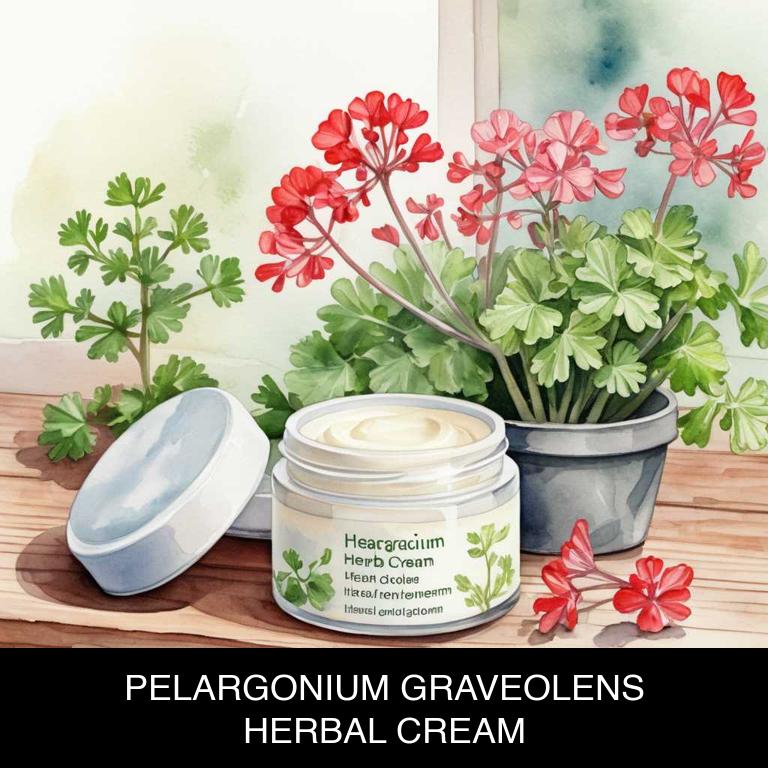
Medicinal Constituents
The list below shows the primary medicinal constituents in Pelargonium graveolens creams that help with dermatitis.
- Geraniol: Acts as an anti-inflammatory and antioxidant agent, helping to soothe and calm irritated skin associated with dermatitis.
- Linalool: Exhibits anti-inflammatory and antimicrobial properties, reducing redness, swelling, and the risk of infection commonly associated with dermatitis.
- Rosmarinic acid: Demonstrates potent antioxidant and anti-inflammatory activities, protecting the skin from oxidative stress and inflammation that can contribute to the development and exacerbation of dermatitis.
Parts Used
The list below shows the primary parts of geranium used to make creams for dermatitis.
- Leaves: The essential oil extracted from Pelargonium graveolens leaves is used to make creams for dermatitis due to its anti-inflammatory and soothing properties.
- Flowers: The essential oil from Pelargonium graveolens flowers is used in creams for dermatitis due to its antimicrobial and anti-inflammatory effects, which help to calm irritated skin.
- Seeds: The extract from Pelargonium graveolens seeds is used to make creams for dermatitis due to its antiseptic and anti-inflammatory properties, which aid in the healing process of skin irritations.
Quick Recipe
The following recipe gives a procedure to make a basic geranium for dermatitis.
- Gather 100g of dried pelargonium graveolens flowers and 500g of base cream in a sterilized environment.
- Infuse 100g of dried pelargonium graveolens flowers in 1l of carrier oil at 60-70°c for 2 hours.
- Strain the infused oil through a cheesecloth or a coffee filter into a clean container.
- Mix 50g of the infused oil with 250g of base cream and 2 tablespoons of preservative in a stainless steel bowl.
- Whip the mixture with a hand mixer at medium speed for 5-7 minutes until it becomes smooth and creamy.
What is the best combination of herbal creams to use for dermatitis?
The best combination of herbal creams that help with dermatitis is a blend of calendula, aloe vera, and tea tree oil.
Calendula is known for its anti-inflammatory properties and ability to soothe irritated skin. Aloe vera provides hydration and calming effects, while tea tree oil has antimicrobial properties that help combat infections. This combination helps to reduce redness, itching, and inflammation associated with dermatitis, promoting faster healing and improved skin health.
Regular application of this blend can lead to significant symptom relief.
What ailments similar to dermatitis are treated with herbal creams?
Ailments similar to dermatitis/creams.html">dermatitis/creams.html">dermatitis that are treated with herbal creams are eczema, psoriasis, and keratosis pilaris.
These conditions often involve inflammation, itchiness, and dryness of the skin. Herbal creams containing soothing ingredients like aloe vera, chamomile, and tea tree oil can help alleviate these symptoms.
Additionally, herbs like calendula, lavender, and gotu kola have anti-inflammatory and antioxidant properties that can further reduce redness, irritation, and itching associated with these conditions.